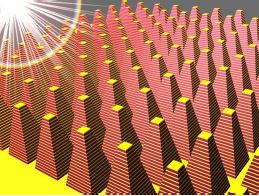Electromagnetic absorbers based on plasmonic and metamaterial structures are of great interest for many areas as narrowband absorbers.
A variety of approaches have been proposed to achieve broadband absorption, which is needed for applications such as solar energy harvesting.
Hangzhou (China) – Early research on electromagnetic (EM) absorbers dates back to 1902 when Wood observed the anomalous dips in the reflection spectra of metallic gratings under illumination of a white-light source.

EM wave absorbers are devices in which the incident radiation at the operating wavelengths can be efficiently absorbed, and then transformed into ohmic heat or other forms of energy. Thereby, neither transmission nor reflection is produced when a wave passes through a perfect absorber.
There are various types of configurations being used as EM absorbers, such as lamellar gratings, convex grooves, spherical voids, and hole arrays. These absorbers are made of noble metals, and associated with plasmonics that contains interesting physical phenomena associated with planar or localized due to the excitation of surface plasmon polaritons (SPPs).
Metamaterials are artificial assemblies of structured elements of subwavelength size, i.e. much smaller than the wavelength of the incident waves. The effective permittivity and permeability can be designated from zero to infinity, and as a result, various unique properties that are not available in nature can be finally achieved.
In a review article, scientists from Zhejiang University in Hangzhou and the Taiyuan University of Technology in China give an overview on the principle of different types of narrowband EM absorbers as well as the various approaches to achieve broadband/multiband absorbers.
Many mechanisms of EM absorption based on metallic structures as well as metamaterial-based schemes are described and the authors discuss how to improve the performance of the absorption band.
A series of plasmonic and metamaterial structures can work as efficient narrowband absorbers due to the excitation of plasmonic or photonic resonances, providing a great potential for selective thermal emitters, biosensing, etc.
In other applications such as solar-energy harvesting and photonic detection, the bandwidth of light absorbers is required to be quite broad. A variety of mechanisms of broadband/multiband absorption have been proposed, such as mixing multiple resonances together, exciting phase resonances, slowing down light by anisotropic metamaterials, employing high loss materials.
The most profound application area of EM absorbers is solar-energy harvesting. Every
improvement is of great significance to society, bringing both economic and environmental benefits. In the future, low-cost, easily fabricated, and high-performance solar absorbers will be in high demand for building economic solar plants. Despite the progress made in producing high-performance EM absorbers, their industrial realization still remains a challenge.